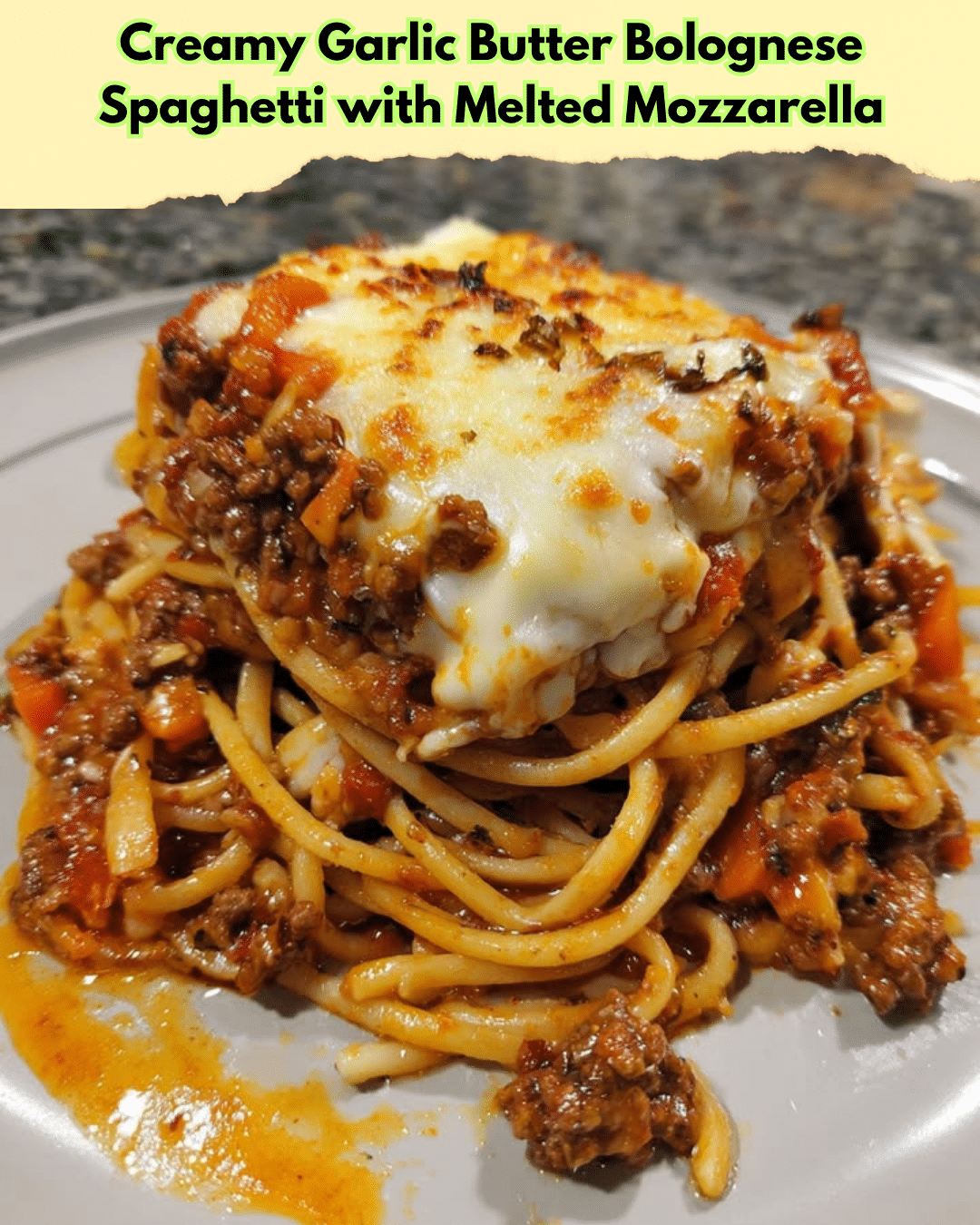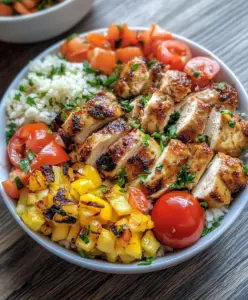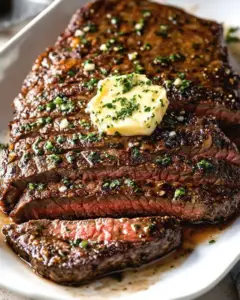Creamy Garlic Butter Bolognese Spaghetti with Melted Mozzarella: A Rich and Savory Delight
The Creamy Garlic Butter Bolognese Spaghetti with Melted Mozzarella is an indulgent meal perfect for a cozy dinner at home. This rich dish combines the comforting flavors of traditional Bolognese with a creamy garlic butter sauce, topped with gooey, melted mozzarella for the ultimate cheese lover’s dream. Imagine a warm bowl that fills the room with the savory aroma of garlic and butter, mingling with the earthy scent of a well-simmered Bolognese. It’s a recipe that appeals to all senses, making it hard to resist going back for seconds.
Pasta lovers will be thrilled with this creamy Bolognese spaghetti as it takes classic spaghetti to new heights with its decadent flavor profile. The combination of garlic butter and the velvety texture of mozzarella elevates the dish beyond a typical pasta meal. Each strand of spaghetti is drenched in the luscious sauce, ensuring that every bite is as satisfying as the last. Not only does this dish promise to satisfy your Italian cravings, but it also brings an Italian comfort food spirit right into your kitchen.
Quick Recipe Highlights
- Flavor Profile: The dish features a harmonious blend of garlic and butter, with a robust Bolognese sauce, all enhanced by the creaminess of melted mozzarella.
- Texture: Expect a delightful combination of creamy sauce, tender spaghetti, and the chewy texture of melted cheese in every mouthful.
- Aroma: The fragrance of sautéed garlic and onion cooking in butter sets a mouthwatering tone, enriched by simmering tomatoes and herbs.
- Visual Appeal: A colorful bolognese sauce, speckled with herbs and covered in golden-brown mozzarella, creates a feast for the eyes.
- Skill Level Needed: Intermediate cooking skills required, with basic sautéing and simmering techniques involved.
- Special Equipment: A large skillet or saucepan is a must for combining all the components harmoniously.
Recipe Overview
- Difficulty Level: This dish is moderate in difficulty due to the layering of flavors and the need to manage different cooking stages.
- Category: This recipe falls into the category of main courses that are perfect for hearty meals.
- Cuisine: Rooted in Italian cuisine with a creative twist, bringing a fusion of classic and modern elements to your table.
- Cost: Ingredients are generally affordable, making it a budget-friendly option for cheese and pasta lovers.
- Season: Perfect for any season thanks to its comforting nature; especially excellent during fall and winter months.
- Occasion: Ideal for family dinners, casual gatherings, or whenever you crave a comforting pasta dish.
Why You’ll Love This Recipe
From the moment you start sautéing the garlic in butter, the kitchen fills with an irresistible aroma, hinting at the flavors to come. The taste of this Creamy Garlic Butter Bolognese Spaghetti with Melted Mozzarella is nothing short of amazing. Each element works in harmony to deliver a flavorful and satisfying experience. The garlic butter enhances the savory meat sauce, while the mozzarella adds a creamy, chewy texture that’s hard to resist.
Convenience is another hallmark of this recipe. Although it requires a bit of prep and cooking skills, the steps are straightforward, making it accessible for home cooks looking to impress. Preparing this spaghetti dish allows for plenty of hands-free time, giving you a chance to relax as it simmers and the flavors deepen.
The nutritional profile offers a hearty dose of protein from the meat, along with essential vitamins and minerals from the tomatoes and cheese. While the dish is indulgent, it remains a balanced meal that can fit well into a varied diet, especially when served with a fresh salad or a side of roasted vegetables.
Cooking this dish is also a social activity, a perfect opportunity for family or friends to gather around the stove, contribute to the cooking process, or simply enjoy the enticing aroma wafting throughout the house. When served, it creates an atmosphere of warmth and shared enjoyment at the dining table.
Considering cost-effectiveness, the ingredients for this dish are readily available and affordable, giving you a gourmet meal experience at home without breaking the bank. This comfort food is an accessible luxury anyone can enjoy on a regular basis.
Historical Background and Cultural Significance
The origins of Bolognese sauce can be traced back to Bologna, Italy, where the traditional ragù holds a cherished place in culinary history. Over time, various versions have emerged, reflecting regional ingredients and personal preferences. Adding a creamy garlic butter twist to this timeless sauce is an homage to Italian-American cuisine, showcasing a blend of traditional and contemporary flavors.
In Italian culture, pasta is a staple that carries significant importance, symbolizing family, unity, and home-cooked comfort. The inclusion of butter and cream reflects the northern Italian culinary traits where dairy is often used to enrich pasta sauces. Mozzarella adds another layer of authenticity, being one of Italy’s most beloved cheeses.
This recipe has evolved by adapting to modern palates that appreciate indulgent flavors and the satisfying melt of cheese when paired with pasta. As global influences shape cooking styles, this dish demonstrates how traditional recipes can be innovated and personalized while still honoring their roots.
Across regions and countries, versions of this creamy garlic butter bolognese can be found, each with varying ingredients and techniques that reflect local tastes and available ingredients. For instance, New York’s Italian-American eateries might highlight this dish on their specials, showcasing it as a cozy, filling meal option for pasta enthusiasts.
Ingredient Deep Dive
The main ingredient, mozzarella, has a rich cultural history as a symbol of Italian cheese excellence. Originally hailing from the Campania region, it’s known for its milky flavor and stretchy texture. Nutritionally, mozzarella provides a good source of calcium, protein, and fats, essential for bone health and muscle function.
Tomatoes, key to the Bolognese sauce, are another ingredient steeped in cultural significance. Once considered exotic in Europe, they now define Italian cuisine. They are rich in vitamins C and A and are known for their antioxidant properties. Selecting vine-ripened tomatoes ensures a natural sweetness that deepens during the cooking process.
Garlic, synonymous with Italian cooking, brings bold flavor and numerous health benefits. Known for its antiviral and antibacterial properties, it supports immune health and adds a piquant note that enhances the savory elements of this dish. Opt for fresh garlic cloves for the most potent flavor.
Olive oil, the base for sautéing, is not only a staple of Mediterranean diets but also a heart-healthy ingredient rich in monounsaturated fats and antioxidants. Opt for extra virgin olive oil for its superior flavor and nutritional benefits and store it in a cool, dark place to maintain its integrity.
Beef and pork used in the Bolognese sauce should be of good quality to ensure flavorful meat that melds perfectly with the other ingredients. Selecting a blend of ground meats provides a balance of taste, while lean options ensure a healthier outcome without excess fats.
Common Mistakes to Avoid
- Using pre-shredded mozzarella, which often contains additives that prevent proper melting, can result in a less creamy texture.
- Skipping the garlic sauté step will lead to a lack of depth in flavor, as the caramelization process brings out the best in garlic.
- Overcooking the pasta is a common pitfall; aim for an al dente texture to ensure the right bite.
- Forgetting to let the sauce simmer means missing out on a richer, more concentrated flavor profile.
- Not seasoning at each stage can lead to a bland dish; always taste and adjust throughout the process.
- Using non-fresh tomatoes or canned alternatives can result in a less vibrant sauce.
- Attempting to shortcut by not blending the meats well can affect the texture consistency in the Bolognese sauce.
- Neglecting to allow the cheese time to properly melt can result in uneven textures across the dish.
Essential Techniques
Sautéing garlic and onions at the beginning of the recipe is crucial for building layers of flavor. This technique caramelizes the sugars, creating a rich base for the sauce. Mastering the gentle heat needed to prevent burning is key, looking for a golden hue as an indicator of readiness.
Simmering sauce is essential for melding flavors and ensuring the meat is tender. A slow simmer allows the ingredients to marry, leading to a harmonious sauce. Patience and timing are important here; avoid boiling to prevent the sauce from becoming too thick or breaking.
The art of melting mozzarella to perfection requires careful temperature control. Achieving a gooey, creamy topping involves even heat and timing, ensuring the cheese doesn’t separate or become rubbery. Look for a smooth, stretchy consistency as a sign of success.
When cooking the spaghetti, reaching al dente is essential; it translates to “to the tooth” and indicates a firm yet tender bite. Opt for a taste test close to the suggested cooking time to prevent overcooking.
Balancing flavors involves constant tasting and seasoning. Use salt, pepper, and herbs incrementally to avoid overpowering the dish and achieving a balanced taste to suit your preferences.
Pro Tips for Perfect Creamy Garlic Butter Bolognese Spaghetti
Ensure the pot of boiling water is well-salted; it should taste like the sea, enhancing the pasta’s natural flavors. Don’t forget to reserve some pasta water before draining for emulsifying the sauce at the end.
Allow the Bolognese sauce time to cool slightly before adding mozzarella, preventing separation and ensuring smooth texture integration. Additionally, always keep an eye on heat levels when melting cheese to avoid scorching.
To enhance garlic flavor, consider using a mix of minced and thinly sliced garlic. The minced version will dissolve into the sauce, while slices will offer subtle bursts of flavor.
Invest in a quality grater for mozzarella, ensuring the cheese melts uniformly. Freshly grated mozzarella is superior for achieving the stretch and creaminess that characterize the dish.
Don’t rush the simmering step; low and slow cooking is vital for developing robust flavors and tenderizing the meat. Time is your ally in creating the richest sauce possible.
Feel free to experiment with a blend of cheeses for a personalized twist; adding a touch of Parmesan can enhance savory notes and deepen overall flavor complexity.
Variations and Adaptations
Regional variations of this dish see the use of different herbs, such as basil in Southern Italy or rosemary in the North, offering a distinct profile based on location. You can adapt based on available fresh herbs, keeping it aligned with your palette preferences.
As seasons change, consider incorporating seasonal ingredients like roasted bell peppers in the summer or mushrooms during autumn for added depth and a twist on tradition. These changes keep the dish exciting and aligned with the freshest produce.
Dietary modifications can accommodate various needs, such as using gluten-free pasta alternatives or opting for plant-based cheeses for a vegan spin. These adaptations ensure everyone can enjoy the deliciousness regardless of dietary restrictions.
Give the sauce a flavor variation by including a splash of red wine during the cooking process to impart rich complexity and a slight acidic note balancing the creamy mozzarella.
For a texture modification, adding toasted pine nuts or breadcrumbs over the finished dish provides a delightful crunch, contrasting with the softness of the spaghetti and creaminess of the cheese.
Presentation alternatives abound; serve it as a baked pasta in individual ramekins for an elegant dinner party or family gathering, elevating the dinner experience.
Serving and Presentation Guide
For plating, use a deep white dish to allow the vibrant colors of the pasta and sauce to pop. Twirl the spaghetti using a fork for a neat presentation, then top it evenly with mozzarella.
Garnishing with fresh basil leaves or a sprinkle of chopped parsley adds a burst of color and a fresh finish to the dish. These green elements not only enhance aesthetics but also complement the flavor profile.
Traditionally, this pasta pairs with garlic bread or a lightly dressed side salad, balancing richness with a crisp, refreshing side. For a modern take, offer roasted seasonal vegetables.
Ensure ideal servings by pre-portioning your pasta, using kitchen tongs for a professional touch. This ensures uniformity and a visually pleasing plate for every guest.
Temperature is crucial for serving; aim for hot, steamy pasta at the table, ensuring the cheese remains melt-in-your-mouth perfection. Pre-warming the serving plates enhances this experience.
Consider portion control by using a measuring cup for even servings, beneficial for larger gatherings to maintain consistency and ensure every guest receives their share.
Wine and Beverage Pairing
For a wine pairing, opt for a medium-bodied red wine like Chianti or a Barbera, which complements the richness of the cream sauce and the tangy tomato backdrop. These wines cut through the richness and enhance the meal experience.
If you’re searching for a non-alcoholic beverage, consider a sparkling water with lemon or a premium grape juice. These options cleanse the palate between bites and offer a refreshing counterpart to the savory spaghetti.
Pairing with coffee is non-traditional, but if applicable, a lightly brewed espresso can be a delightful end to the meal, offering a complementary bitterness after the creamy main dish.
Mind the temperature of your chosen wine, serving reds slightly below room temperature to allow their flavors to shine next to the warm pasta. This ensures a balanced experience.
Serving suggestions include decanting the wine before the meal, enhancing flavors and allowing guests a leisurely start to their dinner as the aromas mix and set the mood.
Storage and Shelf Life
Store leftover spaghetti in an airtight container, ensuring freshness by minimizing air exposure. Ideally, use a glass or BPA-free plastic container with a secure lid.
Keep refrigerated within two hours of serving to maintain safety and quality. Pasta generally remains good for up to three days when properly stored.
Reheat in the oven at 350°F (180°C) for 10–15 minutes to warm through without drying out. Adding a splash of water or broth before reheating helps retain moisture.
Freeze any unserved portions promptly, using freezer-safe bags or containers to extend the dish’s life for up to three months. Thaw in the refrigerator overnight before reheating.
Look out for spoilage signs, such as off odors or a change in color. These indicate the spaghetti is past its prime and should not be consumed.
If reheating in the microwave, a lower heat setting prevents the cheese from becoming rubbery; cover lightly to trap moisture without creating steam pockets.
Make Ahead Strategies
For ahead-of-time preparation, cook the meat sauce a day in advance, allowing flavors to meld as it sits in the fridge, enhancing the taste when reheated.
Store sauce separately from pasta to avoid the latter becoming overly soft or absorbing too much moisture. Combine before serving for the best texture.
Consider chilling the mozzarella before grating it on the make-ahead day, keeping it fresh and easy to sprinkle over the reheated dish without clumping.
Lay the foundation for a seamless meal by setting your table and arranging serving ware ahead of time, maximizing the enjoyment of minimal prep on the meal day.
Refresh the pasta with a quick toss in olive oil before serving to prevent sticking and promote a glossy finish at the table.
Introduce fresh elements last minute, like torn basil or parsley, to retain bright color and fresh aroma when finalizing the meal.
Scaling Instructions
Halving the recipe for a smaller group or intimate dinner keeps it manageable while maintaining the essential flavors. Reduce cooking time slightly, monitoring for texture.
Doubling or tripling requires proportionate increases in ingredient quantities; adjust pot sizes to handle the expanded volume effectively for even cooking.
Consider equipment adjustments by using larger pans or multiple sheets when increasing the recipe size to ensure even heat distribution and thorough cooking.
Scrutinize timing modifications with added attention if scaling; more significant volumes tend to lengthen cooking durations naturally due to denser content.
Ensure appropriate storage considerations by procuring ample containers beforehand, especially when planning for freezer space in advance.
Maintain recipe integrity by paying attention to seasoning when scaling, ensuring flavors translate seamlessly without dilution across larger portions.
Nutritional Deep Dive
A single serving of this dish offers a well-rounded macro profile, with carbohydrates from the pasta, providing energy, and protein from both meat and cheese supporting muscle repair and growth.
Micronutrient contributions come predominantly from the tomatoes and cheese, with calcium aiding in bone health and vitamin C bolstering immune function.
Health benefits arise from the incorporation of healthy fats sourced from olive oil and minimally processed cheese, contributing to heart health while offering satiety.
Dietary considerations involve adherence to balanced consumption, accounting for the indulgence present in the creamy cheese and butter base to integrate into a controlled diet.
Each portion aids energy levels given its carbohydrate content, and the protein quotient supports active individuals by replenishing critical muscle nourishment post-exercise.
For weight management, account for the pasta’s inherent calorie density, balancing portions with a mindful eye to nutritional density per serving.
Dietary Adaptations
To make a gluten-free version, swap traditional wheat spaghetti for rice, quinoa, or corn-based alternatives. Ensure cross-contamination is avoided to cater to coeliac requirements.
Dairy-free adaptations involve substituting mozzarella with plant-based cheese options, maintaining the creamy texture at minimal compromise to flavor.
For a vegan take, replace meat with a plant-based protein like lentils or soy crumbles, omitting butter and cheese in favor of oil and vegan alternatives for a comprehensive adaptation.
Low-carb seekers can explore zucchini or shirataki noodles, significantly reducing the carbohydrate content while offering a pleasant textural contrast to Bolognese elements.
Keto participants can pursue a more cheese-heavy approach, emphasizing fats while minimizing pasta, accompanied by increased meat for higher protein.
Paleo and low-FODMAP adherents can focus on gluten-free, grain-free pasta made from almond or coconut flour, ensuring supportive adaptations to respective guidelines.
Troubleshooting Guide
For texture issues like overly soft pasta, employ immediate rinsing with cold water to halt cooking and preserve al dente quality, ensuring immediate eating.
A bland flavor profile often results from under-seasoning; incrementally add salt or pepper, tasting frequently until desired depth is achieved.
Address temperature problems by ensuring oven preheating before reheating, preventing a cold-and-hot-discrepancy that impacts consistency and palatability.
Equipment challenges, such as a lack of proper pans, can be managed by splitting ingredient volumes across available pots, maintaining equal cooking times.
Ingredient substitutions should aim for similar flavor profiles; soy or almond milk can replace cream, maintaining consistency while addressing dietary needs.
Timing concerns stem from mistiming key steps; embrace the use of kitchen timers and thermometers to maintain control over the cooking process, ensuring precision across stages.
Recipe Success Stories
Our community appreciates this recipe’s versatility and delicious outcome, frequently praising the indulgence and homeliness it brings to the table.
Variations like adding a pinch of red pepper flakes for spice or incorporating creamy ricotta before serving have become reader favorites, sparking creativity.
Adaptation stories often highlight success with plant-based versions, receiving accolades from those seeking dietary-friendly comfort foods that don’t skimp on flavor.
Reader suggestions often revolve around the inclusion of fresh herbs, such as oregano and thyme, enhancing myriad flavors while adding visual appeal to the finished dish.
Photography tips abound, emphasizing natural light and simple setting arrangements to highlight the dish’s vibrant, appealing colors and rich textures.
Frequently Asked Questions
- Can I use a different type of pasta? Yes, while spaghetti is traditional, feel free to experiment with penne, fettuccine, or any sturdy pasta that holds cream sauces well.
- How can I make the recipe spicier? Add chili flakes or freshly diced peppers into the sauce during the start of simmering for increased heat.
- What is the best way to reheat leftovers? Use a low-temperature oven setting or stovetop with a splash of liquid for gradual warming and moisture retention.
- Can I use other cheeses besides mozzarella? Certainly. Gouda, fontina, or asiago can substitute, providing unique flavor spins while maintaining meltability.
- Is there a vegetarian alternative for the Bolognese? Easily swap meats for lentils, mushrooms, or tempeh to achieve a satisfyingly hearty, meatless sauce.
- Why did my cheese not melt properly? Insufficiently grated or poor-quality cheese could prevent full melting; opt for freshly grated higher-quality mozzarella.
- Can I prepare the sauce ahead of time? Definitely! The sauce is perfect for making ahead, allowing flavors to intensify when stored properly in the refrigerator.
- What can I serve alongside this dish to balance richness? A crisp garden salad or lemon-roasted vegetables pair well, offering bright, palate-refreshing contrasts.
- How do I prevent my pasta from sticking? Stir frequently as it cooks, and rinse lightly post-cook while adding a drizzle of olive oil to separate strands.
- Can gluten-free pasta be prepared the same way? It can, though monitor closely, as gluten-free varieties may require slight timing adjustments for al dente achievement.
Additional Resources
For further culinary exploration, consider checking out our related recipes like classic lasagna or creamy Alfredo for a complete pasta experience.
Technique guides available via our platform walk through the art of sautéing, simmering, and strategic seasoning, elevating your overall ticket to cooking mastery.
Ingredient information can delve deeper into fresh produce selection, cheese varieties, and preservation methods to keep your kitchen well-stocked with essentials.
We offer further equipment recommendations, ranging from skillet selections to the optimal cheese graters, enhancing your effectiveness and efficiency in the kitchen.
Seasonal variations keep the recipe dynamic; our dedicated section proposes adjustments, ensuring fresh, seasonal cuisine year-round with the freshest elements.
Print
Creamy Garlic Butter Bolognese Spaghetti with Melted Mozzarella
Description
A rich and savory spaghetti dish featuring a garlic butter bolognese sauce with melted mozzarella for a cheesy finish.
Ingredients
For the Crust:
- 400g spaghetti
- 2 tbsp butter
- 4 garlic cloves, minced
- 500g ground beef
- 1 onion, chopped
- 1 can (400g) crushed tomatoes
- 1/2 cup heavy cream
- Salt and pepper to taste
- 1 tsp dried oregano
- 2 cups shredded mozzarella
- Chopped fresh parsley for garnish
Instructions
1. Prepare the Crust:
- Cook the spaghetti according to package instructions, drain and set aside.
- In a large skillet, melt the butter over medium heat. Add the minced garlic and sauté until fragrant.
- Add the ground beef and onion to the skillet, cooking until the meat is browned and the onion is soft. Stir in crushed tomatoes, heavy cream, salt, pepper, and oregano. Simmer for 15 minutes.
- Preheat your oven to 180°C (350°F). In a baking dish, combine the cooked spaghetti with the bolognese sauce. Top with shredded mozzarella.
- Bake in the oven for 10 minutes or until mozzarella is bubbly and golden. Garnish with parsley before serving.
Notes
You can customize the seasonings to taste.




